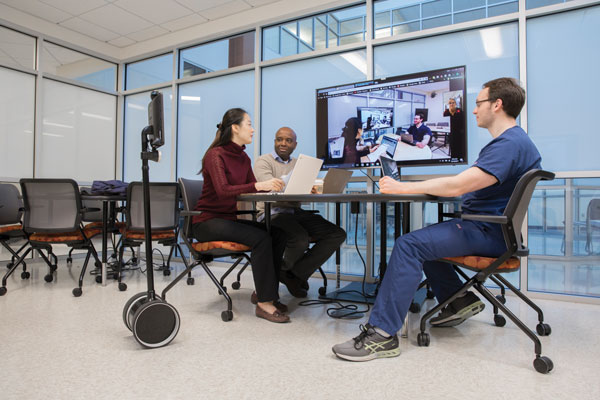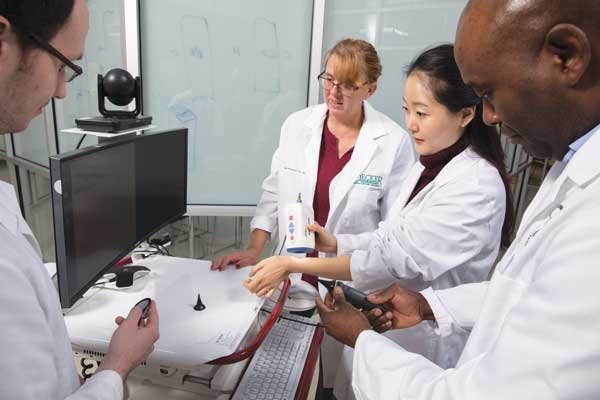Screen time can be healthy
Nurses use telemedicine to expand patient options

Telemedicine has been called the future of medical care for so long that the first time an MDphone transtelephonic defibrillator was plugged into a phone jack and used to restart a woman’s heart remotely, many people were just being introduced to the internet — the dial-up version.
With enormous gains in telecommunications technology since then, telemedicine makes sense now more than ever.
“Nurses are probably the most long-term users of telehealth,” says Ann Fronczek, MS ’99, assistant professor in the Decker School of Nursing. They may be accustomed to using a phone to remotely monitor a cardiac patient — checking blood pressure, weight and heart-rate patterns, for example. But now they can use video technology to facilitate a patient’s “office visit” with a healthcare provider via computer or to capture images to send to a specialist. The patient does not need to travel.
“We’re trying to prepare graduates for this new era in care and how health services in general are expanding in all different ways,” Fronczek says.
To do that, Fronczek and Mohammad T. Khasawneh, professor of systems science and industrial engineering in Binghamton’s Thomas J. Watson School of Engineering and Applied Science, teamed up to create the Southern Tier Telemedicine and Mobile Health Research Development and Training Center, funded with a grant from the Regional Economic Development Corporation.
Undergraduates in the Decker School may already have some experience with telehealth just by using devices such as fitness trackers on their watches or phones. But using a telemedicine cart to conduct a physical exam on a patient for a healthcare provider who is miles away requires integrating nursing and technology.
Practice makes perfect
“We’ve built a little ‘playground.’ If someone is envisioning what’s possible, they can see [the equipment], play with it, touch it,” Fronczek says. “The telemedicine cart allows us to conduct an entire visit; you can hear heartbeat and lung sounds, we have an otoscope [to examine ear canals and membranes] and an exam camera with high-definition transmission.”
Telemedicine is not intended to replace traditional nursing care.
“It’s a whole different type of care, but as nurses we don’t want to lose that human touch,” Nicole Rouhana, MS ’95, PhD ’11, director of graduate nursing programs, says.
Judy Kitchin, clinical lecturer, will teach undergraduates how to use the equipment to interact and communicate with patients by dividing them up in labs across campus and using the technology for some role-playing.
“We’ll ask how they felt as the provider and how they felt as the patient, to learn how best to assess people over the screen while maintaining a nursing presence,” she says.
Helping rural hospitals
The Decker School goes beyond training students in the art and science of telemedicine. Using federal workforce grants, it also works with hospitals in six surrounding rural communities to train their healthcare providers to use telemedicine to help deliver high-quality care to underserved patients.
UHS Delaware Valley Hospital in Walton, N.Y., about 60 miles from Binghamton, is one site.
“Because we live in an area with challenging travel due to lack of public transportation and mountainous terrain, and our service area includes those who are economically disadvantaged, it can be very difficult, if not impossible for them to get to a specialist,” says Dotti Kruppo, director of community relations for the hospital. “Telehealth provides access to care that otherwise is inaccessible.”
At Delaware Valley, three RNs have been trained as telepresenters. A telepsych service [for psychiatric assessment and care] was created using equipment provided by Decker and a connection with a practice in Vestal, N.Y.
“We have only had one patient, but from all accounts he was very pleased with the way the session went, as was the doctor,” Kruppo says.
“We may be looking to start up cardiology, and another initiative we will definitely be doing is video-conferencing — offering an opportunity for area residents to sit in and take part, in real time, in a seminar, support group or other educational program,” she says.
Recruitment and retention of nurses in rural communities like Walton can be a struggle.
“We’re looking to grow our own nurse practitioners in these rural counties,” Rouhana says. “Our nurse practitioner students complete 660 hours of supervised direct patient care in these clinical settings,” she says. “As a state organization we cannot pay the preceptors; however, we can offer equipment, expertise and continuing education.”
Success will be measured in different ways.
One is how providers’ knowledge and attitudes about caring for people in rural settings might change. “There is a stigma about rural people, about who they are and how they want to receive care,” Rouhana says.
Metrics can track improved access to care, the number of providers trained in telemedicine and how many hospitalizations are prevented, Fronczek says.
Already, rural patients seem to love it.
“There is literature that says a telehealth encounter is as good as, if not better than, an in-person visit because of the convenience factor,” Fronczek says. “Once they figure out they don’t have to drive 75 miles to see a specialist, they’re happy to embrace the technology.”

